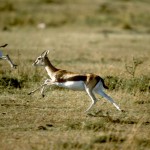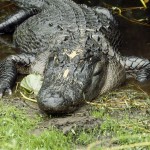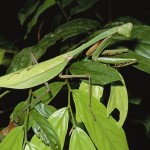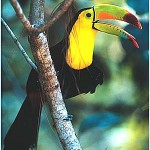Archive for the ‘Wildlife A-Z’
-
Terrific Thomson’s Gazelles
Posted in Wildlife A-Z | April 30, 2010 Gazelles belong to the antelope family. These medium-sized antelopes are found predominantly in Africa and Asia. Small numbers are found far east in Mongolia. There are 19 different species of gazelles. Gazelles are grazing antelopes and live in herds. The herd may include ten to hundred animals. They form large groups in the plentiful rainy season. These groups may contain thousands of gazelles. Wide-open spaces and plains serve as the grazing areas for these gazelles. They feast on grass, shoots, and leaves. Open plains make them vulnerable to predators such as cheetahs and wild dogs. However, gazelles can run very fast. These gazelles can reach speeds of 40 miles per hour. Some species of gazelles prefer the mountainous landscapes and deserts. [...]
Gazelles belong to the antelope family. These medium-sized antelopes are found predominantly in Africa and Asia. Small numbers are found far east in Mongolia. There are 19 different species of gazelles. Gazelles are grazing antelopes and live in herds. The herd may include ten to hundred animals. They form large groups in the plentiful rainy season. These groups may contain thousands of gazelles. Wide-open spaces and plains serve as the grazing areas for these gazelles. They feast on grass, shoots, and leaves. Open plains make them vulnerable to predators such as cheetahs and wild dogs. However, gazelles can run very fast. These gazelles can reach speeds of 40 miles per hour. Some species of gazelles prefer the mountainous landscapes and deserts. [...] -
Awesome American Alligator
Posted in Wildlife A-Z | April 28, 2010 The American alligator is a rare story of success for an endangered animal to be saved from extinction. The numbers of the American alligator continue to thrive. The population has improved due to federal protection and habitat conservation efforts. The demand for alligator products has also reduced. The population is presently in excess of one million. These menacing predators have lizard-like bodies, muscular tails, and powerful jaws. They appear well armored. Research has put the alligator species at around 150 million years old. Their prehistoric partners included dinosaurs. They managed to avoid extinction some 65 million years ago. American alligator inhabit freshwater rivers, lakes, swamps, and marshes. They are found in large numbers [...]
The American alligator is a rare story of success for an endangered animal to be saved from extinction. The numbers of the American alligator continue to thrive. The population has improved due to federal protection and habitat conservation efforts. The demand for alligator products has also reduced. The population is presently in excess of one million. These menacing predators have lizard-like bodies, muscular tails, and powerful jaws. They appear well armored. Research has put the alligator species at around 150 million years old. Their prehistoric partners included dinosaurs. They managed to avoid extinction some 65 million years ago. American alligator inhabit freshwater rivers, lakes, swamps, and marshes. They are found in large numbers [...] -
Patient Praying Mantis
Posted in Wildlife A-Z | April 22, 2010 The praying mantis gets its name due to the prominent front legs. They are often bent and held at an angle, which suggests the position of prayer. The larger group of these insects is known as praying mantids. Mantis indicated the genus, mantis. Only a few praying mantids belong to these genus. Irrespective of the name, these insects are wonderful predators. Their head are triangular and situated on a long ‘neck’ or extended thorax. Mantids have the ability to turn their heads 180 degrees. They are able to scan their surroundings with the help of two large compound eyes. They are green or brown in color. They are well camouflaged on the plants on which they live. Mantids are known for their ambushes. They patiently stalk their prey. They [...]
The praying mantis gets its name due to the prominent front legs. They are often bent and held at an angle, which suggests the position of prayer. The larger group of these insects is known as praying mantids. Mantis indicated the genus, mantis. Only a few praying mantids belong to these genus. Irrespective of the name, these insects are wonderful predators. Their head are triangular and situated on a long ‘neck’ or extended thorax. Mantids have the ability to turn their heads 180 degrees. They are able to scan their surroundings with the help of two large compound eyes. They are green or brown in color. They are well camouflaged on the plants on which they live. Mantids are known for their ambushes. They patiently stalk their prey. They [...] -
Amazing Asian Elephant
Posted in Wildlife A-Z | April 21, 2010 The elephant is the world’s largest animal. The Asian elephant is slightly smaller than its African counterpart. The Asian elephant can be distinguished by their small, rounded ears. The ears of the African elephant resemble the contours of the African continent. To keep cool, ears of the elephant radiate heat. This is not always enough. Elephants love playing in water. They suck water with the help of their trunks and spray it all over their body. The elephant’s trunk is in reality a long nose and has many functions. Elephants use their trunk for smelling, breathing, drinking, grabbing things, and sounding the trumpet. The trunk contains nearly 100,000 diverse muscles. A finger-like feature at the end of the trunk is characteristic of Asian [...]
The elephant is the world’s largest animal. The Asian elephant is slightly smaller than its African counterpart. The Asian elephant can be distinguished by their small, rounded ears. The ears of the African elephant resemble the contours of the African continent. To keep cool, ears of the elephant radiate heat. This is not always enough. Elephants love playing in water. They suck water with the help of their trunks and spray it all over their body. The elephant’s trunk is in reality a long nose and has many functions. Elephants use their trunk for smelling, breathing, drinking, grabbing things, and sounding the trumpet. The trunk contains nearly 100,000 diverse muscles. A finger-like feature at the end of the trunk is characteristic of Asian [...] -
Majestic Monarch Butterflies
Posted in Wildlife A-Z | April 21, 2010 Monarch butterflies are renowned for their mass migration. This migration brings millions of them to California and Mexico every winter. North American Monarchs are the only species of butterflies that undertake such a massive journey, which includes more than 3000 miles. The winters are particularly harsh; therefore, they need to make this journey every autumn. Monarch butterflies start life’s journey as eggs. They then hatch as larvae and eat their eggshells. They then feed on milkweed plants. These butterflies are wholly dependent on milkweed plants. Over the course of time, fattening larvae become juicy and colorful caterpillars. While they enter the pupa stage, they form a hard protective case around themselves. Their primary colors [...]
Monarch butterflies are renowned for their mass migration. This migration brings millions of them to California and Mexico every winter. North American Monarchs are the only species of butterflies that undertake such a massive journey, which includes more than 3000 miles. The winters are particularly harsh; therefore, they need to make this journey every autumn. Monarch butterflies start life’s journey as eggs. They then hatch as larvae and eat their eggshells. They then feed on milkweed plants. These butterflies are wholly dependent on milkweed plants. Over the course of time, fattening larvae become juicy and colorful caterpillars. While they enter the pupa stage, they form a hard protective case around themselves. Their primary colors [...] -
Tremendous Toucan
Posted in Wildlife A-Z | April 20, 2010 South America’s tropical forests are home to the Toco toucan. These beautiful birds are recognized everywhere. The oversized, colorful bill is characteristic of the bird. This has ensured that the toucan is one of the world’s most popular birds. The bill extends for 7.5 inches. It can be viewed as a mating trait; however, both male and female toucans possess these bills. Both, males and females use their bills to obtain tasty morsels of food. They pitch this food to one another during a fruit toss, which is characteristic of a mating ritual. When it comes to weaponry, the bill is more of a showcase item and does pack much substance. It is a honeycomb of bone and contains a lot of air. The size of the bill may prove a deterrent for predators. [...]
South America’s tropical forests are home to the Toco toucan. These beautiful birds are recognized everywhere. The oversized, colorful bill is characteristic of the bird. This has ensured that the toucan is one of the world’s most popular birds. The bill extends for 7.5 inches. It can be viewed as a mating trait; however, both male and female toucans possess these bills. Both, males and females use their bills to obtain tasty morsels of food. They pitch this food to one another during a fruit toss, which is characteristic of a mating ritual. When it comes to weaponry, the bill is more of a showcase item and does pack much substance. It is a honeycomb of bone and contains a lot of air. The size of the bill may prove a deterrent for predators. [...] -
Wonder of the Ivory-billed Woodpecker
Posted in Wildlife A-Z | April 9, 2010 The ivory-billed woodpecker was considered till recently to be an extinct species. However, its obscurity vanished when ornithologists have reported its sighting. The ivory-billed woodpecker is the third largest woodpecker species in the world. It was believed to be extinct some 50 years ago. However, in April 2005 a video featuring the birds surfaced from an Arkansas swamp forest. This video confirmed the existence of the bird. It captured the attention of the entire world. It was considered to be the equivalent of locating Elvis alive. Some researchers backed the evidence for the ivory-billed woodpecker while other insisted that the video recording shows a smaller woodpecker, which is common throughout North America. These woodpeckers make [...]
The ivory-billed woodpecker was considered till recently to be an extinct species. However, its obscurity vanished when ornithologists have reported its sighting. The ivory-billed woodpecker is the third largest woodpecker species in the world. It was believed to be extinct some 50 years ago. However, in April 2005 a video featuring the birds surfaced from an Arkansas swamp forest. This video confirmed the existence of the bird. It captured the attention of the entire world. It was considered to be the equivalent of locating Elvis alive. Some researchers backed the evidence for the ivory-billed woodpecker while other insisted that the video recording shows a smaller woodpecker, which is common throughout North America. These woodpeckers make [...] -
Splendor of the Great Egret
Posted in Wildlife A-Z | April 8, 2010 The great egret is a long-legged bird whose neck takes an ‘S-shape’. It is found throughout the Americas. Many diverse areas of the world are home to this species. It is regarded as the largest white egret that occurs within its range. The great blue heron is the only species larger than the great egret. Great egrets are found near salt water or fresh water. Their feeding areas include wetlands, streams, ponds, and tidal flats. They capture prey by walking silently or standing still for long periods of time. Any animal that comes within range of their long necks and razor-sharp bills is potential prey. The ultimate death blow is given with an immediate thrust of the sharp bill. The prey is then swallowed whole. Fish serves as the staple [...]
The great egret is a long-legged bird whose neck takes an ‘S-shape’. It is found throughout the Americas. Many diverse areas of the world are home to this species. It is regarded as the largest white egret that occurs within its range. The great blue heron is the only species larger than the great egret. Great egrets are found near salt water or fresh water. Their feeding areas include wetlands, streams, ponds, and tidal flats. They capture prey by walking silently or standing still for long periods of time. Any animal that comes within range of their long necks and razor-sharp bills is potential prey. The ultimate death blow is given with an immediate thrust of the sharp bill. The prey is then swallowed whole. Fish serves as the staple [...] -
Scorching Light of the Fireflies
Posted in Wildlife A-Z | April 8, 2010 The term firefly is common. Fireflies are also known as lightning bugs. However, not many know that these insects are beetles in reality. They are nocturnal insects belonging to the Lampyridae family. Fireflies have wings. This distinguishes them from other luminescent insects belonging to the same family, which are known as glowworms. There are nearly 2000 species of fireflies. They generally live in warm surroundings and temperate regions. They are clearly seen in summer evenings. They love moisture and thrive in the humid regions of Asia and America. Even in drier areas, they are present where there is ample of moisture. It is easy to understand how the fireflies got their name. However, not many know how these insects produce their characteristic [...]
The term firefly is common. Fireflies are also known as lightning bugs. However, not many know that these insects are beetles in reality. They are nocturnal insects belonging to the Lampyridae family. Fireflies have wings. This distinguishes them from other luminescent insects belonging to the same family, which are known as glowworms. There are nearly 2000 species of fireflies. They generally live in warm surroundings and temperate regions. They are clearly seen in summer evenings. They love moisture and thrive in the humid regions of Asia and America. Even in drier areas, they are present where there is ample of moisture. It is easy to understand how the fireflies got their name. However, not many know how these insects produce their characteristic [...] -
Potent Great White Sharks
Posted in Wildlife A-Z | April 7, 2010 In reality the great white shark is not as dangerous as in our imaginations. Recently, there has been a lot of research on these elusive predators. The great white shark is no longer viewed as a mean killing machine. Nearly one-third to one-half of the total shark attacks can be attributed to great whites. Most of these attacks are not fatal. Great white sharks are known to be naturally curious. They engage in what is known as ‘sample biting’ by releasing their victims. This cannot be very comforting news, but it does indicate that humans are not on the menu list of the great white shark. Great white sharks are the largest predatory fish on the planet. Their average length is 15 feet. There have been fish specimens exceeding 20 feet and [...]
In reality the great white shark is not as dangerous as in our imaginations. Recently, there has been a lot of research on these elusive predators. The great white shark is no longer viewed as a mean killing machine. Nearly one-third to one-half of the total shark attacks can be attributed to great whites. Most of these attacks are not fatal. Great white sharks are known to be naturally curious. They engage in what is known as ‘sample biting’ by releasing their victims. This cannot be very comforting news, but it does indicate that humans are not on the menu list of the great white shark. Great white sharks are the largest predatory fish on the planet. Their average length is 15 feet. There have been fish specimens exceeding 20 feet and [...]


